
Journal of Agricultural Engineering
Scope & Guideline
Exploring Cutting-Edge Solutions for Modern Agriculture
Introduction
Aims and Scopes
- Precision Agriculture Technologies:
The journal emphasizes the development and application of precision agriculture technologies, including automated systems, sensors, and data analytics to optimize farming practices and enhance crop yields. - Sustainable Agricultural Practices:
Research on sustainable practices that minimize environmental impact while maximizing productivity is a core focus, including studies on resource management, waste reduction, and energy efficiency. - Mechanization and Equipment Design:
The journal covers advancements in agricultural machinery and equipment design aimed at improving operational efficiency and reducing labor costs in various agricultural sectors. - Environmental Monitoring and Modeling:
A significant area of research involves modeling environmental factors affecting agriculture, including climate impacts, soil health, and water management strategies. - Biotechnology and Crop Improvement:
The journal also addresses the integration of biotechnology in agriculture, focusing on genetic improvements, pest management, and disease resistance in crops.
Trending and Emerging
- Automation and Robotics in Agriculture:
There is a growing trend in research on automation and robotics, with studies focusing on robotic systems for planting, harvesting, and monitoring crops, enhancing efficiency and reducing labor demands. - Artificial Intelligence and Machine Learning Applications:
The application of AI and machine learning in agriculture is increasingly prominent, with research devoted to predictive analytics for crop management, disease detection, and yield forecasting. - Climate Resilience and Adaptation Strategies:
Research focusing on climate resilience is on the rise, examining how agricultural systems can adapt to changing climatic conditions and mitigate adverse effects on food production. - Data-Driven Decision Making:
Emerging studies emphasize the use of big data and analytics in agriculture, promoting data-driven decision-making processes that enhance operational efficiency and sustainability. - Smart Irrigation Technologies:
Innovations in smart irrigation systems, utilizing sensors and real-time data for irrigation management, are gaining attention, reflecting a shift towards water conservation and efficiency.
Declining or Waning
- Traditional Farming Techniques:
Research related to conventional farming methods has seen a decline as the journal shifts towards more innovative and technology-driven approaches to agriculture. - Chemical Fertilization Studies:
There is a noticeable reduction in publications focused solely on chemical fertilizers, possibly due to a growing emphasis on sustainable practices and organic farming. - Basic Soil Science:
Basic soil science topics have diminished in favor of applied research that integrates soil management with advanced technologies and environmental considerations. - Conventional Irrigation Methods:
Studies centered around traditional irrigation methods are waning, reflecting an increased interest in precision irrigation techniques and water-saving technologies.
Similar Journals

International Journal of Agricultural and Environmental Information Systems
Empowering Research at the Intersection of Agriculture and EnvironmentInternational Journal of Agricultural and Environmental Information Systems, published by IGI Global, is a leading platform for scholarly discourse bridging the domains of agriculture, environmental science, and information systems. With its ISSN 1947-3192 and E-ISSN 1947-3206, this esteemed journal has been pivotal in tackling key information challenges within these crucial fields since its inception in 2010, and it continues to evolve until 2024. Featuring articles ranked in the Q3 category for Information Systems based on Scopus metrics— where it proudly stands at Rank #105 out of 394—this journal occupies a significant position in advancing knowledge dissemination and applied research. The open access option broadens the reach of its valuable content, making it accessible to a diverse audience. The journal's objective is to foster interdisciplinary research and innovations that enhance sustainability in agricultural practices and environmental management. By subscribing to the latest studies and innovations, researchers, professionals, and students can leverage the insights published in the International Journal of Agricultural and Environmental Information Systems to significantly contribute to their fields and foster better decision-making in environmental stewardship and agricultural advancements.

International Journal of Agricultural and Biological Engineering
Transforming agricultural practices with cutting-edge research.Welcome to the International Journal of Agricultural and Biological Engineering, a premier open-access publication dedicated to advancing the fields of agricultural and biological engineering. Established and published by the Chinese Academy of Agricultural Engineering, this journal has been at the forefront of academic discourse since its inception in 2008. With an impact factor that reflects the journal's esteemed reputation, it ranks impressively in the Q2 category for both Agricultural and Biological Sciences and Engineering, showcasing its influence in these vital fields. The journal's commitment to innovation is underscored by its open-access model, ensuring that vital research is accessible to a global audience. Covering a diverse scope of topics relevant to the integration of engineering principles in agricultural practices, this journal is an essential resource for researchers, professionals, and students alike, providing insights that drive advancements and sustainable practices within the industry. With a dedicated editorial board and a rigorous peer-review process, the International Journal of Agricultural and Biological Engineering is poised to contribute significantly to the growth and development of knowledge in agricultural and biological systems.

COMPUTERS AND ELECTRONICS IN AGRICULTURE
Revolutionizing Agriculture with Computing InsightsCOMPUTERS AND ELECTRONICS IN AGRICULTURE, published by Elsevier Science Ltd, is a premier interdisciplinary journal dedicated to the exploration and application of computing and electronic technologies within agricultural sciences. With an impressive impact factor reflected in its Q1 status across multiple categories, including Agronomy and Crop Science, Animal Science and Zoology, and Computer Science Applications, this journal stands out as a leading platform for advancing research in these critical fields. The journal's aims include fostering innovation and facilitating knowledge transfer between academia and industry by disseminating high-quality research that addresses the challenges of modern agriculture through technological solutions. For researchers, professionals, and students dedicated to enhancing agricultural productivity and sustainability, COMPUTERS AND ELECTRONICS IN AGRICULTURE serves as an essential resource, offering insights that push the boundaries of traditional practices while embracing the digital future of agriculture.

Scientific Papers-Series A-Agronomy
Empowering Agricultural Innovation through ResearchScientific Papers-Series A-Agronomy is a premier academic journal dedicated to the field of agronomy, published by the University of Agronomic Sciences and Veterinary Medicine Bucharest. With an emphasis on innovative research and practical applications, this journal serves as a vital platform for disseminating new findings in agricultural science, sustainable practices, and crop management strategies. Though the journal currently operates under traditional access options, it remains pivotal in supporting the academic community in Romania and beyond. The ISSN (2285-5785) and E-ISSN (2285-5807) ensure that the work published is easily accessible to researchers and practitioners alike, fostering the exchange of knowledge and advancements within the agricultural sector. By continually addressing contemporary issues in agronomy, Scientific Papers-Series A-Agronomy strives to promote sustainable agricultural practices and enhance food security, making it an essential resource for professionals, students, and researchers keen on advancing their understanding and expertise in this critical field.

BRAGANTIA
Bridging Academia and Agriculture for a Sustainable FutureBRAGANTIA, published by the Instituto Agronômico, is a distinguished open access journal that has been a vital resource since its inception in 1977. With an ISSN of 0006-8705 and E-ISSN 1678-4499, this journal is recognized for its contributions to the field of Agricultural and Biological Sciences, where it currently holds a respectable Q2 ranking as of 2023. Additionally, BRAGANTIA is indexed in various databases, supporting its impact within Materials Science (Q3 ranking). Positioned in Brazil, the journal promotes the dissemination of high-quality research, aiming to bridge the gap between academia and practical applications in agricultural innovation and sustainability. Researchers, professionals, and students looking to keep abreast of recent advancements and their implications will find BRAGANTIA to be an indispensable platform for sharing and accessing vital agricultural knowledge.

AMA-Agricultural Mechanization in Asia Africa and Latin America
Transforming Agriculture: Insights from Asia, Africa, and Latin AmericaAMA-Agricultural Mechanization in Asia Africa and Latin America is an esteemed journal published by the FARM MACHINERY INDUSTRIAL RESEARCH CORP, dedicated to advancing the field of agricultural mechanization. With a history spanning from 1982 to 2020, this journal has served as a pivotal platform for disseminating innovative research and insights related to agricultural practices and technologies across pivotal regions including Asia, Africa, and Latin America. Although the journal has ceased its coverage in Scopus, its contributions to the fields of Engineering and Agricultural and Biological Sciences remain significant, particularly for professionals and researchers focusing on agricultural engineering dynamics. While it operates under a traditional subscription model, the urgency of its content in mechanization solutions continues to aid in enhancing agricultural productivity and sustainability. Researchers and practitioners alike will find invaluable resources within its pages, reflecting the critical developments in the sector during the late 20th and early 21st centuries.

APPLIED ENGINEERING IN AGRICULTURE
Empowering Agricultural Progress with Applied Engineering Insights.APPLIED ENGINEERING IN AGRICULTURE is a peer-reviewed journal published by the American Society of Agricultural and Biological Engineers, dedicated to advancing the field of agricultural engineering through the dissemination of high-quality research. With an ISSN of 0883-8542 and an e-ISSN of 1943-7838, this journal has been a key resource since its inception in 1985, serving as a vital platform for scholars and practitioners to share innovative ideas and practical solutions that enhance productivity and sustainability in agricultural practices. The journal is ranked in the Q3 category for Engineering (miscellaneous) as of 2023, and is positioned within the 43rd percentile of the general engineering rankings in Scopus. While not currently an open-access journal, APPLIED ENGINEERING IN AGRICULTURE remains crucial for researchers and professionals looking to explore diverse engineering solutions that address the complexities of modern agriculture, making it an invaluable resource for anyone committed to improving agricultural systems through engineering advancements.

Smart Agricultural Technology
Empowering Agriculture Through Smart TechnologySmart Agricultural Technology, an esteemed journal published by ELSEVIER, stands at the forefront of agricultural innovation, with its focus on the intersection of cutting-edge technology and sustainable farming practices. Established in 2021, this Open Access journal is committed to disseminating pivotal research findings in the fields of Agricultural and Biological Sciences, Artificial Intelligence, and Computer Science, ensuring that crucial developments are accessible to all stakeholders. With a notable impact factor denoted by its impressive Q1 and Q2 categorizations, Smart Agricultural Technology ranks among the top journals in its fields, boasting a percentile standing of 76th in Agricultural and Biological Sciences and 68th in Computer Science advancements. Operating out of the Netherlands, the journal offers a dynamic platform for researchers, professionals, and students to explore, share, and drive forward the agenda of smart agriculture through vital interdisciplinary collaboration and knowledge dissemination. Featured in Scopus, it promises not only rigor and excellence but also a vibrant forum for groundbreaking ideas and practices that can transform the agricultural landscape.

Engenharia Agricola
Pioneering research in agricultural engineering excellence.Engenharia Agricola, published by the SOC BRASIL ENGENHARIA AGRICOLA, is a crucial open-access journal that has been at the forefront of agricultural engineering research since its inception in 1981. With an E-ISSN of 1809-4430 and an ISSN of 0100-6916, this journal stands out in the field by providing a platform for disseminating innovative studies and advancements in agricultural practices and technologies. Based in Brazil, the journal emphasizes global perspectives in agricultural and biological sciences, currently positioned in the Q3 quartile of its category, as recognized in the 2023 Scopus Ranks, where it ranks 97 out of 193 publications. Researchers, professionals, and students can access a plethora of high-quality articles that contribute to sustainable agronomy, agricultural mechanics, and resource efficiency across various environments, with open access since 2004, ensuring that critical knowledge is readily available to all stakeholders in the field.

SCIENTIA AGRICOLA
Exploring innovative practices in the heart of agriculture.SCIENTIA AGRICOLA is a prestigious, peer-reviewed journal published by UNIV SAO PAULO, ESALQ, dedicated to advancing the field of agricultural sciences. With the ISSN 1678-992X and an e-ISSN maintaining the same number, this Open Access journal has been a valuable resource since 1992, fostering wide dissemination of knowledge and research findings in agriculture. Hailing from Piracicaba, Brazil, associated with one of the leading agricultural universities, SCIENTIA AGRICOLA serves as an essential platform for researchers, practitioners, and students aiming to explore innovative agricultural practices, crop production, and sustainable techniques. Although specific metrics such as H-Index and Scopus Ranks were not provided, the journal's longstanding commitment to open access and impactful research underscores its importance in contributing to the global dialogue on agricultural efficiency and sustainability.